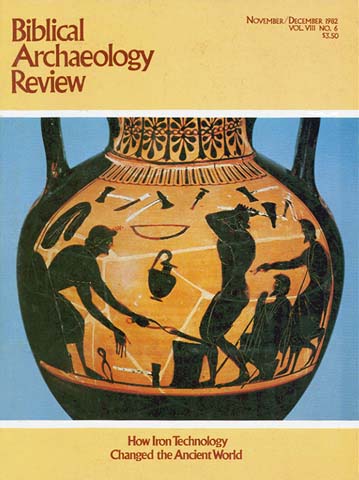Biblical Archaeology Review, November/December 1982

Features
Bible translations are nothing new.
Not since 1769 has the venerable King James Version of the Bible been revised. This year Nelson Publishers brought the King James Version into the twentieth century with care and reverence for its beloved cadences and familiar archaic language.a
The publication of the third section of the Hebrew Bible, The Writings (Kethubim), marks the completion of the new Jewish Publication Society Bible translation, abbreviated NJPS.a This is the first Bible translation executed by a panel of Jewish scholars since the Septuagint, the Greek translation of the Bible completed in Alexandria, Egypt, two millennia […]
Italian archaeologists claim to have discovered the house were Jesus stayed in Capernaum. Proof positive is still lacking and may never be found, but all signs point to the likelihood that the house of St. Peter where Jesus stayed, near Capernaum’s famous synagogue, is an authentic relic. Nestled on the northwest shore of the […]
042 Modern historians divide the roughly 3,000 year-period beginning approximately 3200 B.C. into two major segments—the Bronze Age and the Iron Age. The Bronze Age I extends from about 3200 B.C. to 1200 B.C.a Thereafter it is the Iron Age.b This is some indication of the enormous importance (as well as the date […]
Recent issues of BAR have covered a wide range of views regarding the Israelites’ servitude in Egypt, the parting of the “Red Sea” (the “Reed Sea” in Hebrew), and the route of the Exodus.a The authors were, in the main, archaeologists, linguists and experts in Near Eastern studies. Perhaps it would be appropriate to […]
Professor Larry Geraty of Andrews University gave his class in Biblical Archaeology the instructive assignment of writing a BAR Jr. column. In this issue, we print one of the papers submitted in response. Talk about bringing the Bible to life! Imagine you’re digging at a Judean outpost southeast of Jerusalem, and you unearth correspondence […]
BAR has been able to confirm a New York Times report that the famous antiquities of Tyre have not been seriously damaged either by the PLO occupation of the site or by the war in Lebanon. According to the Times, the PLO placed the ancient Roman ruins of Tyre off-limits even to its Lebanese […]
